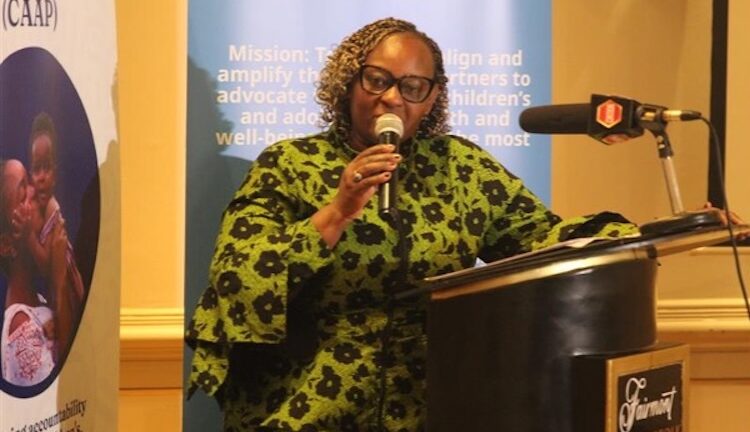Reflections from Kenya’s high-level policy dialogue and civil society convening in Nairobi
By Dr Margaret Lubaale and Lisa Mushega*
Nairobi, Kenya | 30 September 2025 (IDN) — Behind every maternal death in Kenya is a family forever changed. Children lose their mothers, communities lose their leaders, and the country loses its potential.
At a recent Reproductive, Maternal, Newborn, Child, and Adolescent Health and Nutrition (RMNCAH+N) High-Level Policy Dialogue and CSO Roundtable in Nairobi, these stories and statistics came into sharp focus.
With less than five years to the 2030 Sustainable Development Goal (SDG) targets, the two-day convening was an opportunity to accelerate reforms, strengthen accountability, and mobilise political will so that every woman, child, and adolescent can thrive.
The Context of Women’s Health in Kenya
Kenya continues to face unacceptably high maternal mortality, with 355 deaths for every 100,000 live births. This translates to around 6,000 preventable deaths each year — about 16 women dying every single day. To put this in perspective: the loss of mothers in Kenya is the equivalent of a deadly matatu crash happening daily.
- Postpartum haemorrhage (PPH) — the loss of 500 ml of blood after childbirth, roughly the volume of a standard water bottle — is the leading cause of maternal mortality (40%).
- Obstructed labour (28%) and eclampsia (14%) follow, according to the Kenya Health Information System.
- These conditions also significantly contribute to newborn asphyxia, a leading cause of neonatal deaths.
Most of these deaths are preventable through universal access to family planning, quality antenatal and intrapartum care, skilled birth attendance, and emergency obstetric and newborn care (EmONC).
Scaling Up Proven Solutions
Beyond essential medicines such as antibiotics and oxytocics, scaling up access to recent innovations is key:
- Heat-stable carbetocin for preventing PPH
- Tranexamic acid (TXA) for timely bleeding management
- Safe blood transfusions are often lacking in facilities due to shortages of supplies, equipment, and trained staff
In addition, solutions such as the E-MOTIVE approach, point-of-care ultrasound (POCUS) for early detection, and CPAP for newborns with respiratory distress, combined with stronger referral systems and supply chains, could transform outcomes.
Yet facility readiness and antenatal care remain uneven. The 2022 Kenya Demographic and Health Survey (KDHS) reveals that over one-third of pregnant women fail to attend a minimum of four antenatal visits. Inequalities persist:
- Only half of women with no education meet this standard.
- More than eight in ten women with higher education do.
Financing Gaps and Health System Disruptions
Kenya’s shift from the Linda Mama program under NHIF to the new Social Health Insurance Fund (SHIF) has disrupted access to maternal health services. Maternity services, once free, now require out-of-pocket payments, with early signs suggesting a decline in skilled birth attendance.
Persistent socioeconomic divides, health worker shortages, and inadequate referral systems further hinder progress. Behind the statistics, most deaths are preventable, many linked to unintended or poorly supported pregnancies.
Unintended Pregnancies: A Hidden Driver
At the dialogue, participants emphasised that unintended pregnancies remain a critical but under-addressed driver of maternal mortality.
As Hon. Dr James Nyikal, Chair of the National Health Committee, asked: “How many of these deaths are actually coming from a planned pregnancy, and how many are coming from pregnancies that were not desired? There are a lot of maternal deaths that could be avoided by proper contraception.”
Youth voices highlighted the trauma of early, unwanted motherhood. Teenage pregnancy rates remain high at 15% nationally, with wide county variations and continued child marriage. These numbers represent real lives: girls forced out of school, stigmatised, or enduring motherhood without support — perpetuating cycles of poverty and poor health.
While Kenya’s unmet need for family planning has declined from 27% in 2003 to 14% today, disparities remain stark:
- Over 30% of women in West Pokot, Samburu, Siaya, and Isiolo lack access.
- Less than 5% in Laikipia and Embu face the same challenge.
This is despite Kenya’s 2010 Constitution, which enshrines the right to the highest attainable standard of health, including reproductive health and the right to life.
Political Commitments and the Road Ahead
Speaking at the Global Leaders Network side event on the margins of the UN General Assembly this week, President William Ruto reaffirmed Kenya’s commitment to universal health coverage and sustainable financing, declaring:
“The future of Africa’s health financing lies in our own hands.”
The Maternal, Newborn and Child Health Bill (2023), currently before Parliament, could enshrine equitable MNCH services in law and improve coordination between national and county governments. For this promise to translate into action, it must be urgently prioritised and advanced without delay.
As Dr Edward Serem, Head of RMNCAH at the Ministry of Health, reminded participants:
“With all these investments, women are still dying, children are still dying. We still need to put more effort.”
The Time to Act
The toll of maternal mortality is measured not only in lives lost but in futures cut short and communities burdened with unspoken grief. Kenya has the knowledge and tools to change this. What is required now is decisive leadership, bold investment, and collective resolve.
As Kenya prepares to host the International Maternal Newborn Health Conference in 2026, it cannot welcome the world while losing the equivalent of a matatu full of mothers every day.
The fire must keep burning—until women, girls, and children can live and thrive with dignity.
*Dr. Margaret Lubaale is the Executive Director of Health NGOs Network (HENNET). Lisa Mushega is the Collaborative Advocacy Action Plan (CAAP) Focal Point and Legal Policy Expert at HENNET, a partner of PMNCH in Kenya. [IDN-InDepthNews]
Image: Dr Margaret Lubaale, Executive Director of HENNET provided opening remarks during the RMNCAH+N high-level policy dialogue in Nairobi.

